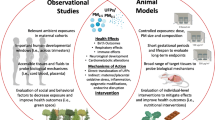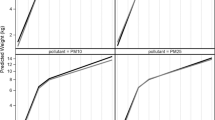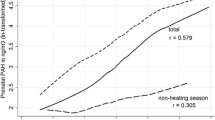Abstract
Outdoor air pollution, largely from fossil fuel burning, is a major cause of morbidity and mortality in the United States, costing billions of dollars every year in health care and loss of productivity. The developing fetus and young child are especially vulnerable to neurotoxicants, such as polycyclic aromatic hydrocarbons (PAH) released to ambient air by combustion of fossil fuel and other organic material. Low-income populations are disproportionately exposed to air pollution. On the basis of the results of a prospective cohort study in a low-income population in New York City (NYC) that found a significant inverse association between child IQ and prenatal exposure to airborne PAH, we estimated the increase in IQ and related lifetime earnings in a low-income urban population as a result of a hypothesized modest reduction of ambient PAH concentrations in NYC of 0.25 ng/m3. For reference, the current estimated annual mean PAH concentration is ~1 ng/m3. Restricting to NYC Medicaid births and using a 5 per cent discount rate, we estimated the gain in lifetime earnings due to IQ increase for a single year cohort to be US$215 million (best estimate). Using much more conservative assumptions, the estimate was $43 million. This analysis suggests that a modest reduction in ambient concentrations of PAH is associated with substantial economic benefits to children.
Similar content being viewed by others
References
American Lung Association. (2013) State of the Air 2013 Report.
Trasande, L. and Liu, Y. (2011) Reducing the staggering costs of environmental disease in children, estimated at $76.6 billion in 2008. Health Affairs (Millwood) 30 (5): 863–870.
Landrigan, P.J., Schechter, C.B., Lipton, J.M., Fahs, M.C. and Schwartz, J. (2002) Environmental pollutants and disease in American children: Estimates of morbidity, mortality, and costs for lead poisoning, asthma, cancer, and developmental disabilities. Environmental Health Perspectives 110 (7): 721–728.
Olden, K., Ramos, R.M. and Freudenberg, N. (2009) To reduce urban disparities in health, strengthen and enforce equitably environmental and consumer laws. Journal of Urban Health 86 (6): 819–824.
Perera, F.P. et al (2002) The challenge of preventing environmentally related disease in young children: Community-based research in New York City. Environmental Health Perspectives 110 (2): 197–204.
Claudio, L., Tulton, L., Doucette, J. and Landrigan, P.J. (1999) Socioeconomic factors and asthma hospitalization rates in New York City. Journal of Asthma 36 (4): 343–350.
Federico, M.J. and Liu, A.H. (2003) Overcoming childhood asthma disparities of the inner-city poor. Pediatric Clinics of North America 50 (3): 655–675.
New York City Department of Health. (1998) Vital Statistics. New York City: New York City Department of Health.
NRC. (1993) Pesticides in the Diets of Infants and Children. Washington DC: National Academy Press.
Perera, F.P. et al (2004) Biomarkers in maternal and newborn blood indicate heightened fetal susceptibility to procarcinogenic DNA damage. Environmental Health Perspectives 112 (10): 1133–1136.
World Health Organization. (1986) Principles for Evaluating Health Risks from Chemicals During Infancy and Early Childhood: The Need for a Special Approach. Environmental Health Criteria 59. Geneva, Switzerland: World Health Organization.
Grandjean, P. and Landrigan, P.J. (2006) Developmental neurotoxicity of industrial chemicals. Lancet 368 (9553): 2167–2178.
Perera, F.P. et al (2012) Prenatal polycyclic aromatic hydrocarbon (PAH) exposure and child behavior at age 6–7. Environmental Health Perspectives 120 (6): 921–926.
Wormley, D.D. et al (2004) Inhaled benzo(a)pyrene impairs long-term potentiation in the F1 generation rat dentate gyrus. Cellular and Molecular Biology (Noisy-le-grand) 50 (6): 715–721.
Perera, F.P. et al (2006) Effect of prenatal exposure to airborne polycyclic aromatic hydrocarbons on neurodevelopment in the first 3 years of life among inner-city children. Environmental Health Perspectives 114 (8): 1287–1292.
Perera, F.P. et al (2009) Prenatal airborne polycyclic aromatic hydrocarbon exposure and child IQ at age 5 years. Pediatrics 124 (2): e195–e202.
Grosse, S.D., Matte, T.D., Schwartz, J. and Jackson, R.J. (2002) Economic gains resulting from the reduction in children’s exposure to lead in the United States. Environmental Health Perspectives 110 (6): 563–569.
Trasande, L., Landrigan, P.J. and Schechter, C. (2005) Public health and economic consequences of methyl mercury toxicity to the developing brain. Environmental Health Perspectives 113 (5): 590–596.
Jusko, T.A., Henderson, C.R., Lanphear, B.P., Cory-Slechta, D.A., Parsons, P.J. and Canfield, R.L. (2008) Blood lead concentrations<10 microg/dL and child intelligence at 6 years of age. Environmental Health Perspectives 116 (2): 243–248.
Pleil, J.D., Vette, A.F., Johnson, B.A. and Rappaport, S.M. (2004) Air levels of carcinogenic polycyclic aromatic hydrocarbons after the World Trade Center disaster. Proceedings of the National Academy of Sciences of the United States of America 101 (32): 11685–11688.
Rundle, A.H. et al (2012) Association of childhood obesity with maternal exposure to ambient air polycyclic aromatic hydrocarbons during pregnancy. American Journal of Epidemiology 175 (11): 1163–1172.
Choi, H. et al (2008) Estimating individual-level exposure to airborne polycyclic aromatic hydrocarbons throughout the gestational period based on personal, indoor, and outdoor monitoring. Environmental Health Perspectives 116 (11): 1509–1518.
Naumova, Y.Y. et al (2002) Polycyclic aromatic hydrocarbons in the indoor and outdoor air of three cities in the U.S. Environmental Science and Technology 36 (12): 2552–2559.
Weiland, K., Neidell, M., Rauh, V. and Perera, F. (2011) Cost of developmental delay from prenatal exposure to airborne polycyclic aromatic hydrocarbons. Journal of Health Care for the Poor and Underserved 22 (1): 320–329.
The New York City Department of Health and Mental Hygiene. (2009) The New York city community air survey: Results from year one monitoring 2008–2009 Stevens L.M. (ed.) New York: New York City Health Department.
Li, W., Kelley, D. and Kennedy, J. (2003) Summary of Vital Statistics 2002: NYC Department of Health and Mental Hygiene.
Grosse, S.D. (2007) How much does IQ raise earnings? Implications for regulatory impact analyses. Association of Environmental and Resource Economists (AERE) 27 (2): 44.
Heckman James, J., Stixrud, J. and Urzua, S. (2006) The effects of cognitive and noncognitive abilities on labor market outcomes and social behavior. Journal of Labor Economics 24 (3): 411–482.
Gold, M.R., Siegel, J.E., Russel, L.B. and Weinstein, M.C. (eds.) (1996) Cost Effectiveness in Health and Medicine. New York: Oxford University Press.
Miller, R.L. et al (2004) Polycyclic aromatic hydrocarbons, environmental tobacco smoke, and respiratory symptoms in an inner-city birth cohort. Chest 126 (4): 1071–1078.
Bostrom, C.E. et al (2002) Cancer risk assessment, indicators, and guidelines for polycyclic aromatic hydrocarbons in the ambient air. Environmental Health Perspectives 110 (Supplement 3): 451–488.
Kaplan, C. (1996) Predictive validity of the WPPSI-R: A four year follow-up study. Psychology in the Schools 33 (3): 211–220.
Lemelin, J. P. et al (2007) The genetic-environmental etiology of cognitive school readiness and later academic achievement in early childhood. Child Development 78 (6): 1855–1869.
Sheffield, P., Roy, A., Wong, K. and Trasande, L. (2011) Fine particulate matter pollution linked to respiratory illness in infants and increased hospital costs. Health Affairs (Millwood) 30 (5): 871–878.
Kan, H. and Chen, B. (2004) Particulate air pollution in urban areas of Shanghai, China: Health-based economic assessment. Science of the Total Environment 322 (1–3): 71–79.
Zhang, M., Song, Y. and Cai, X. (2007) A health-based assessment of particulate air pollution in urban areas of Beijing in 2000–2004. Science of the Total Environment 376 (1–3): 100–108.
Pérez, L., Sunyer, J. and Künzli, N. (2009) Estimating the health and economic benefits associated with reducing air pollution in the Barcelona metropolitan area (Spain). Gaceta Sanitaria 23 (4): 287–294.
Acknowledgements
The National Institute of Environmental Health Sciences (grants 5P01ES09600, 5R01ES08977), the US Environmental Protection Agency (R827027, RD832141, RD83450901), the John and Wendy Neu Family Foundation, the John Merck Fund, the Blanchette Hooker Rockefeller Foundation, and the New York Community Trust supported this study. The authors also thank Dr Julien Teitler, Irwin Garfinkel, Barbara Simons, and Sara Tjossen for their helpful comments.
Author information
Authors and Affiliations
Corresponding author
Additional information
A careful look at exposures to airborne polycyclic aromatic hydrocarbons, helped the authors estimate the effect on the IQ of children in New York City. They estimate the benefits of reducing exposures.
Rights and permissions
About this article
Cite this article
Perera, F., Weiland, K., Neidell, M. et al. Prenatal exposure to airborne polycyclic aromatic hydrocarbons and IQ: Estimated benefit of pollution reduction. J Public Health Pol 35, 327–336 (2014). https://doi.org/10.1057/jphp.2014.14
Published:
Issue Date:
DOI: https://doi.org/10.1057/jphp.2014.14




